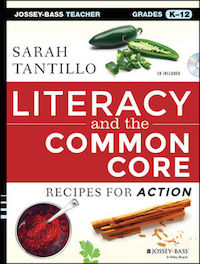Shared Reading Needs to Have a Clear Purpose
 By Sarah Tantillo
By Sarah Tantillo
Recently, while conducting an observation, I saw a teacher direct students to sit in pairs and read an article together. I kept waiting for further directions, but none came.
Students scattered happily to various corners of the room to sit side by side. Some of them read. Some of them took turns reading. Some of them chatted. And there was no telling how long this would go on because the teacher wasn’t using a timer.
I have no doubt that this teacher was not intentionally trying to waste time. But I was struck by what a missed opportunity this was. What did this teacher expect students to glean from the text? As I’ve explained in a previous blog post, it’s vital to set our purpose when reading (and train students to set their own). In this case, I saw no evidence of purpose. Among 13 pairs of students, I observed 13 different approaches to shared reading.
Our primary job as teachers is to maximize student learning. Shared reading has the potential to be a useful vehicle for learning if implemented effectively. Let’s talk about how to make that happen.
Why Shared?
Before you decide to use a shared reading approach, consider the pros and cons.
Shared reading has several benefits:
1) Stronger readers can support strugglers; strugglers who might stare into space during silent reading time cannot opt out during partner reading time.
2) 
3) Students can move at their own pace.
4) Unlike when individuals read silently, teachers can monitor progress by circulating and listening; they can stop and support any students who need help.
5) With partners engaged in this focused work, teachers can simultaneously run reading groups or writing conferences.
On the flip side, there are some drawbacks:
1) Shared reading can become an exercise in listening comprehension if both partners are not looking at the text; listening alone does not strengthen reading comprehension. (Incidentally, for the same reason, those “reading” tests some teachers give after they’ve read aloud and discussed a story all week are actually listening comprehension tests.)
2) You cannot assess independent reading comprehension if students are not reading independently.
3) Students who are paired with struggling readers may become frustrated.
How to Get the Most Out of Shared Reading
If you’ve decided that the pros outweigh the cons, here are some strategies to maximize the opportunities inherent in this approach:
Model the behavior you expect. As with any activity, we cannot assume students popped out of the womb knowing how to read effectively with a partner. In a quick role-play, you can clarify your expectations and defuse any anxiety students may have about how to “perform” in this activity.
- After modeling, it’s always a good practice to give students a few minutes to try out the approach, then pause the class to give some feedback on what you’ve observed. Offer praise and suggest tweaks, then set the timer again and let them get back to work.
- There is not one “right” way to run partner reading, but make sure that your approach engages both partners constantly. While the designated reader is reading, what is the other student doing (besides also reading along silently)? Is he/she preparing to ask a question (ideally, a “Why” or “How” question)? Preparing to answer a question they came up with together? Analyzing the text for a particular purpose (e.g., because “today we’re trying to figure out what kind of person Ponyboy is” or “we’re looking for things that surprise us in this article” or any number of other possible purposes)? How often are they supposed to switch roles? (PS, it’s best if they have targets such as a paragraph or two rather than something that requires you to be involved with the timer.)
- Clarify how partners should capture their ideas (e.g. on an organizer of some sort) and how the class will follow through on this partner reading. For example, “After we finish this chapter, we’ll run several Socratic seminars to hear what people figured out about Ponyboy.” Or, “After this, we’re going to use our notes to write a quick character analysis of Ponyboy.”
Partnering for writing feedback
The other really cool thing about partner reading is that it can also be used for students to give one another feedback on their writing.

This question can be either a request for clarification (“What do you mean in that sentence?”) or a request for elaboration (“Why do you think Ponyboy said that?”). Questions along these two lines—as opposed to statements such as “That’s confusing,” which can raise defensive hackles—show that the reader is genuinely interested. More importantly, they also invite the writer to explain.
Which is what good writers do. Relentlessly.
________________


 Model the behavior you expect. As with any activity, we cannot assume students popped out of the womb knowing how to read effectively with a partner. In a quick role-play, you can clarify your expectations and defuse any anxiety students may have about how to “perform” in this activity.
Model the behavior you expect. As with any activity, we cannot assume students popped out of the womb knowing how to read effectively with a partner. In a quick role-play, you can clarify your expectations and defuse any anxiety students may have about how to “perform” in this activity.




























